Abstract
1. The temperature-dependent component of the resting potential in intact, cannulated and dialysed fibres from the muscle of the barnacle Balanus nubilus was studied under a variety of different experimental conditions. A decrease in temperature from 22 to 12° C produced a mean depolarization of 10 mV.
2. Neither addition of strophanthidin, nor replacement of external sodium by lithium affect the voltage shift induced by temperature. However, the magnitude of the voltage shift depends on the external chloride and potassium concentration.
3. The dialysis technique was applied to measure the potassium, chloride and sodium fluxes as a function of temperature. The Q10 for the passive fluxes of these ions was 1·9, 1·7, and 1·4 respectively.
4. The temperature-dependent changes in the passive ionic fluxes combined with the inability of inhibitors of the sodium pump to alter the temperature dependence of the resting potential suggest that the change induced by temperature on the resting potential is primarily caused by a change in the passive permeability ratios, and is not related to active ion transport.
Full text
PDF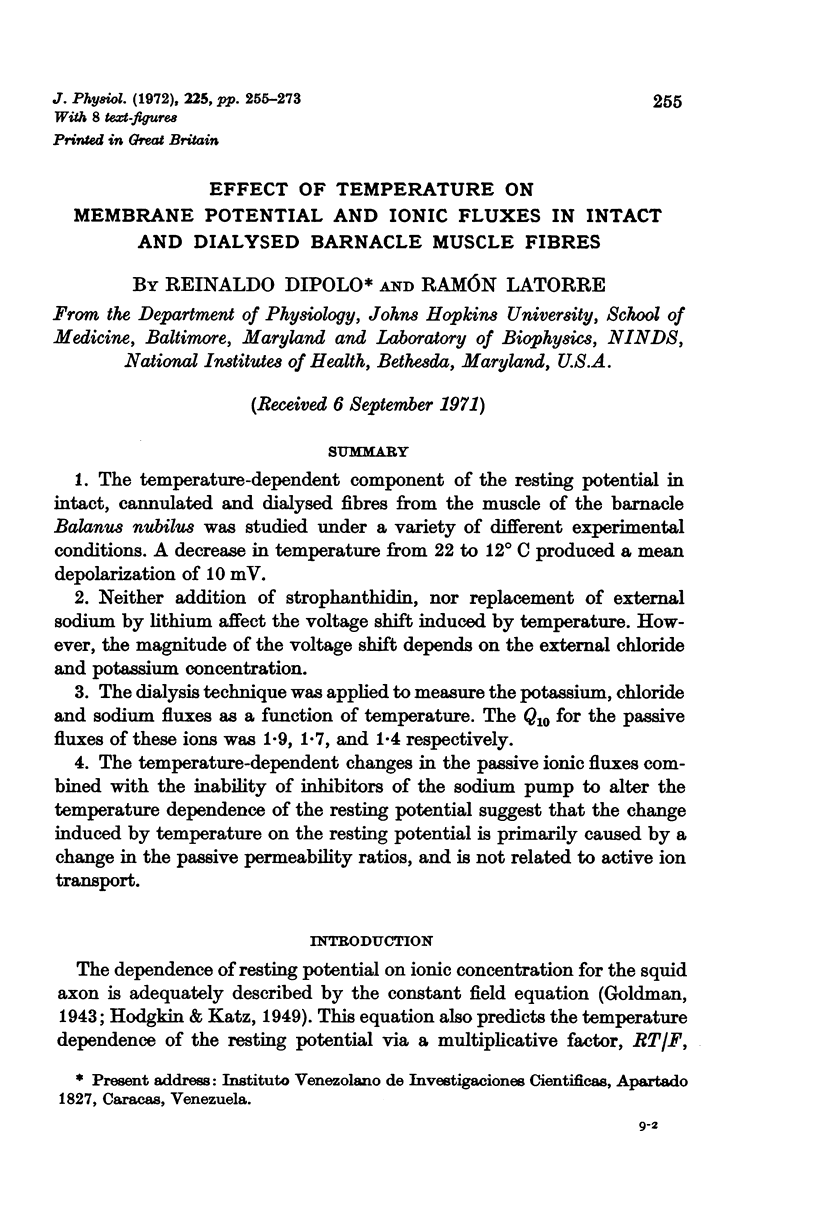
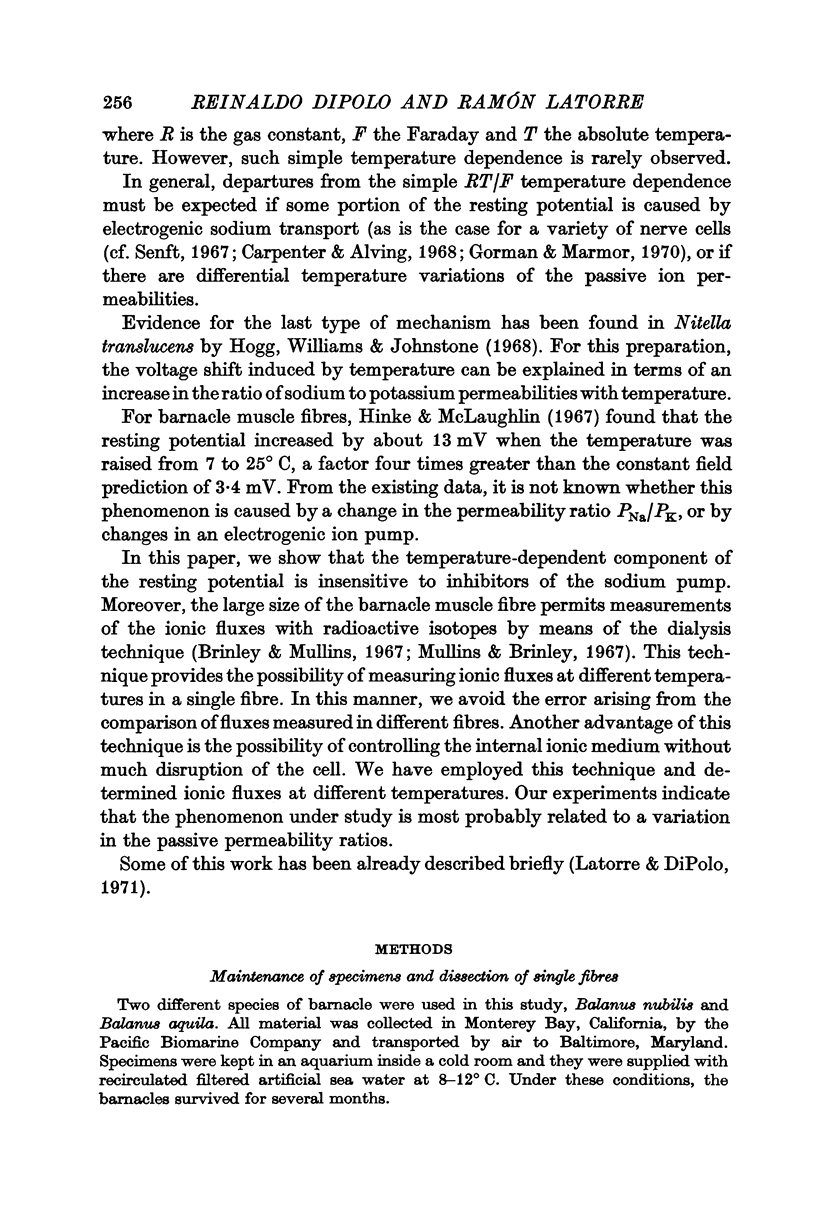
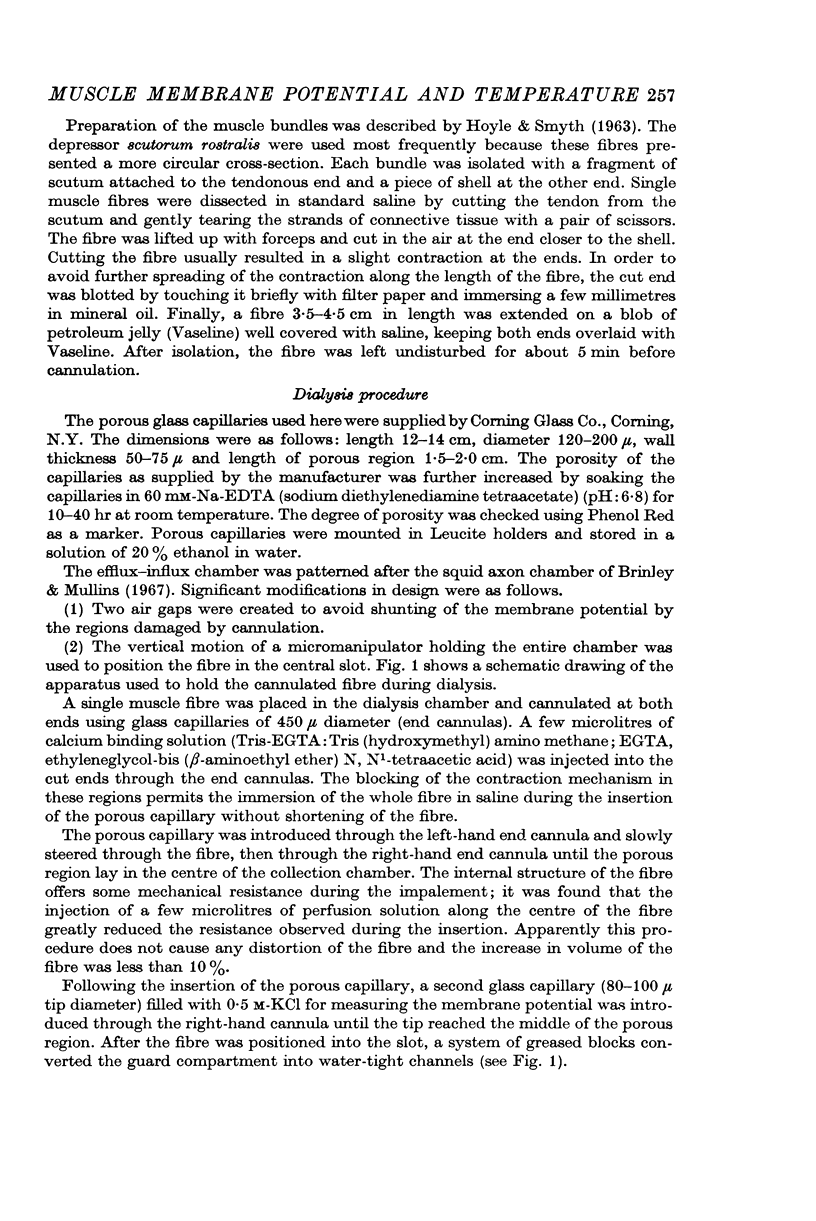





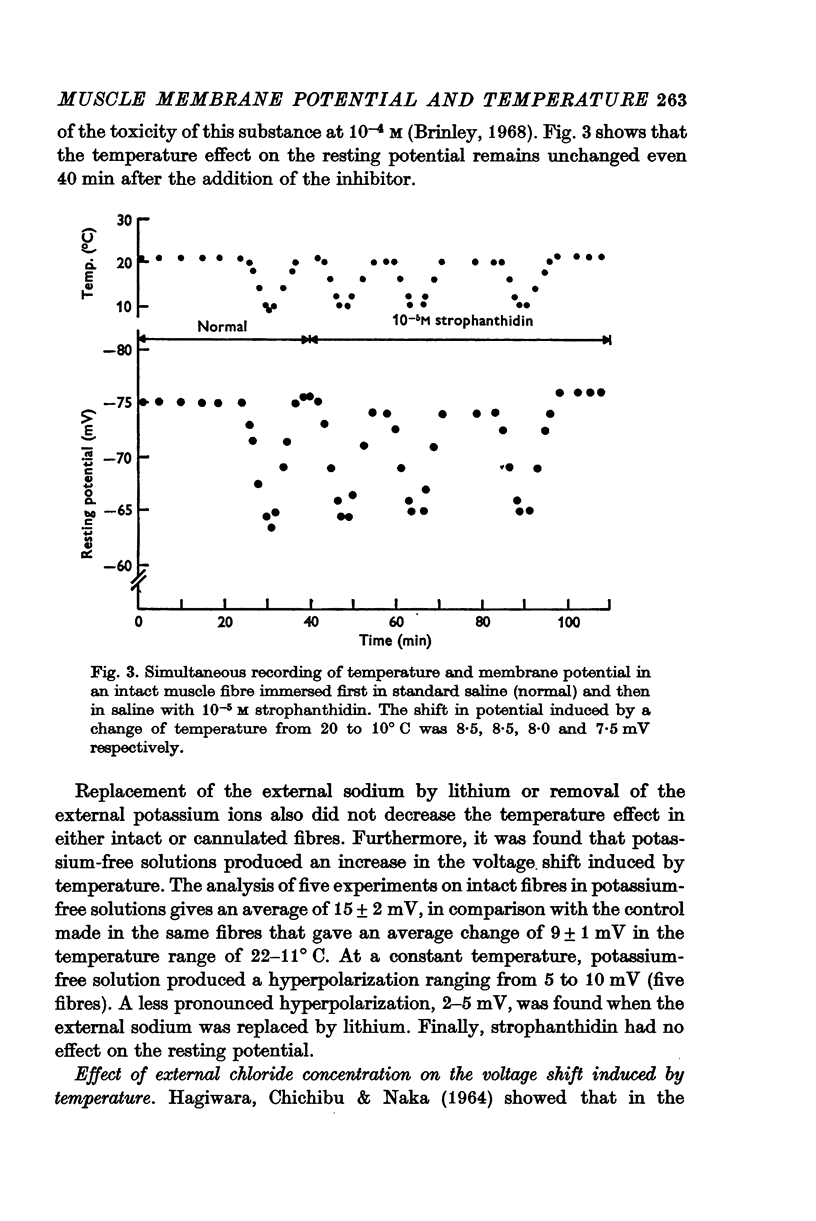

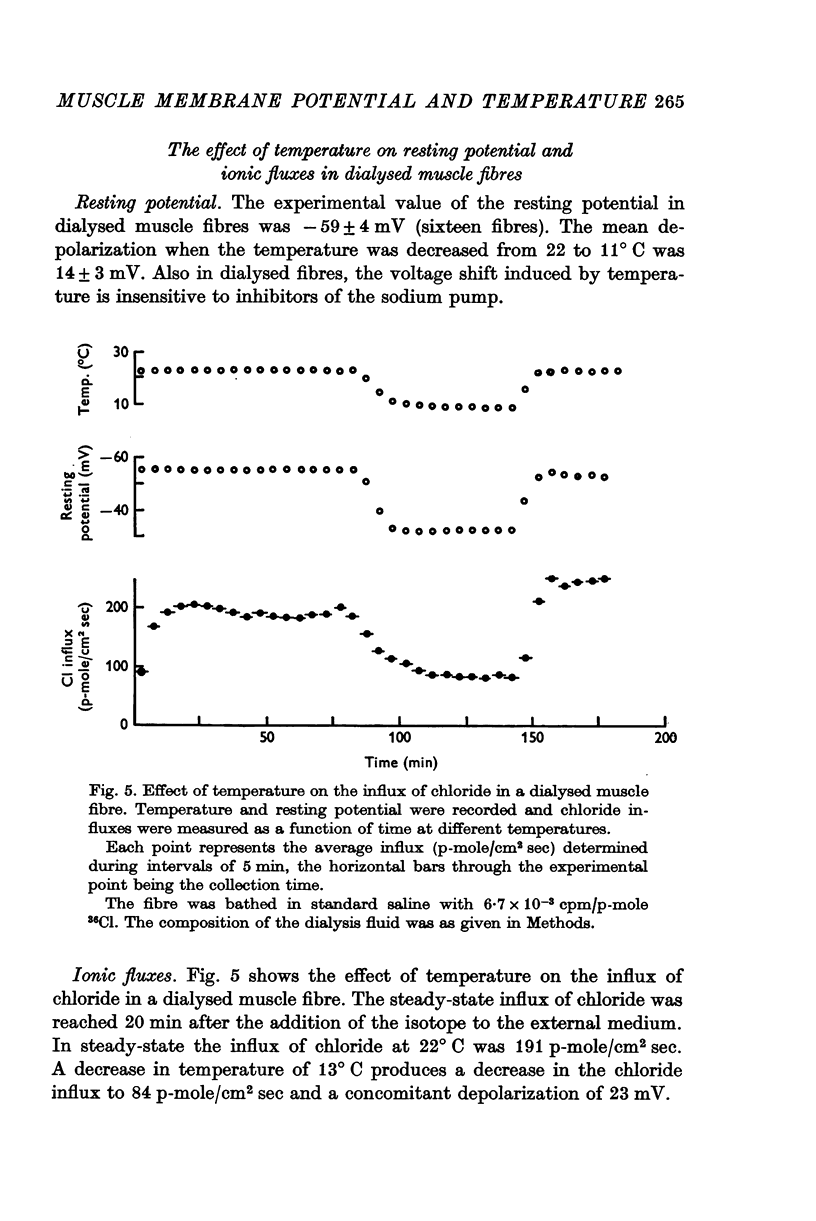

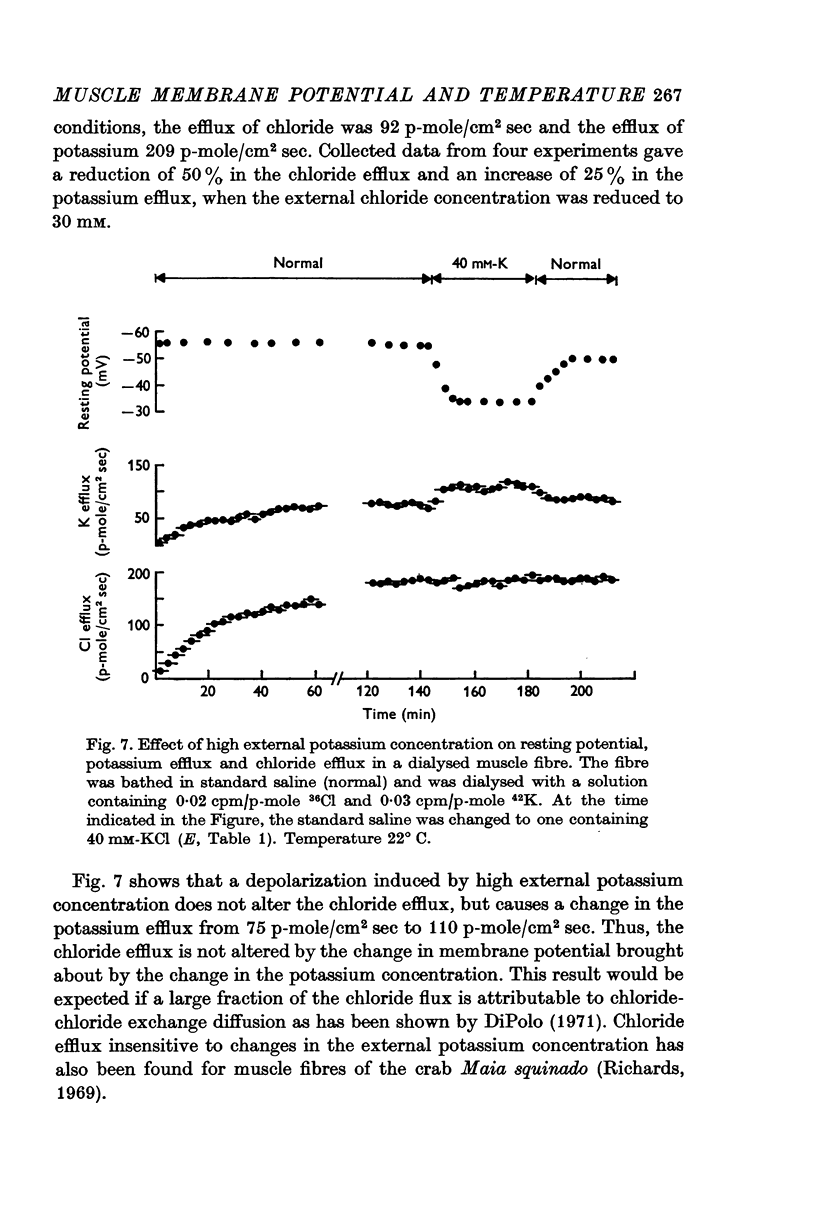
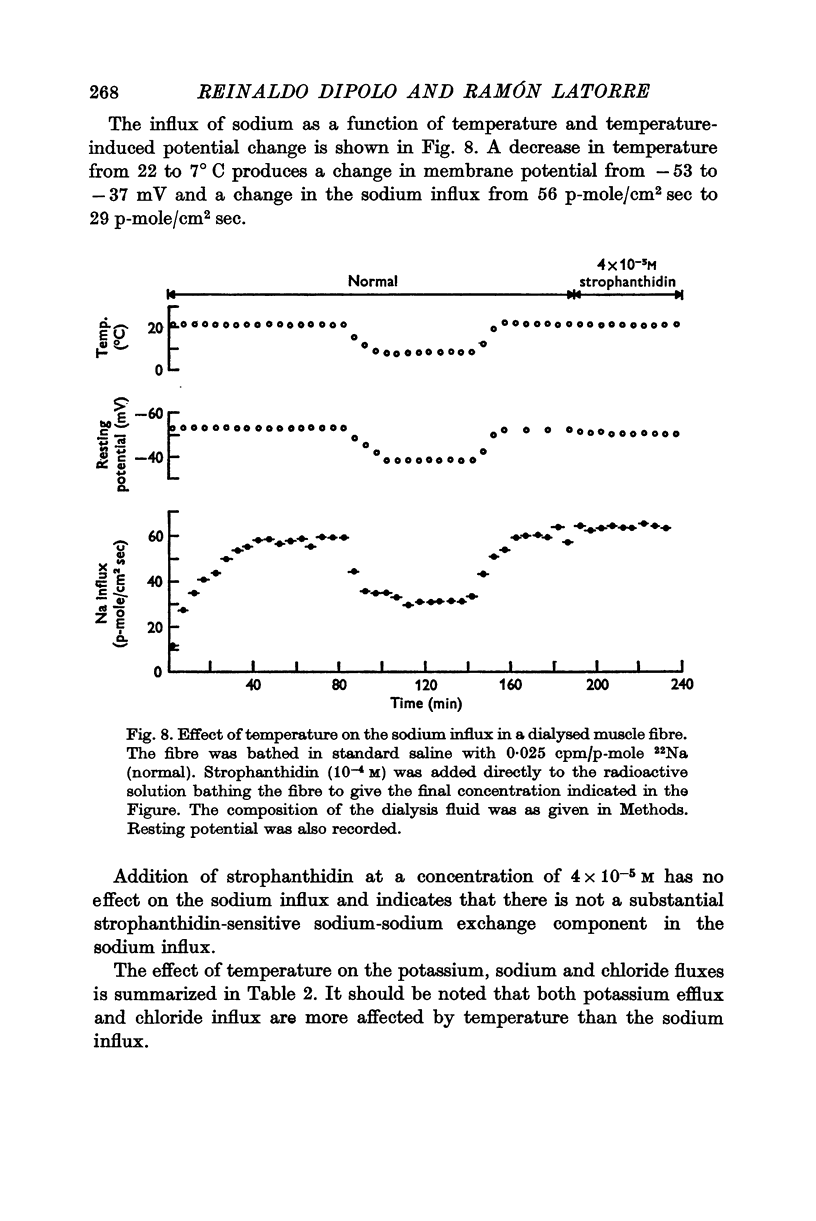
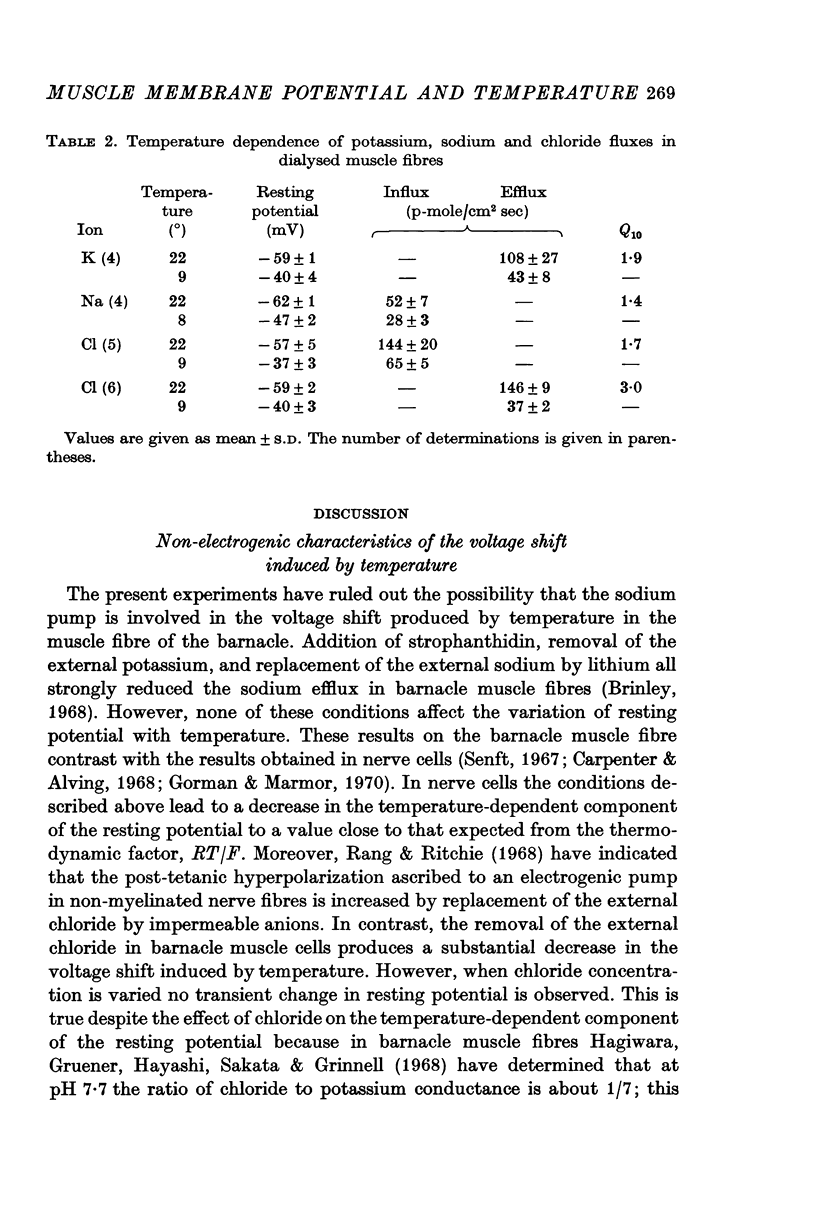
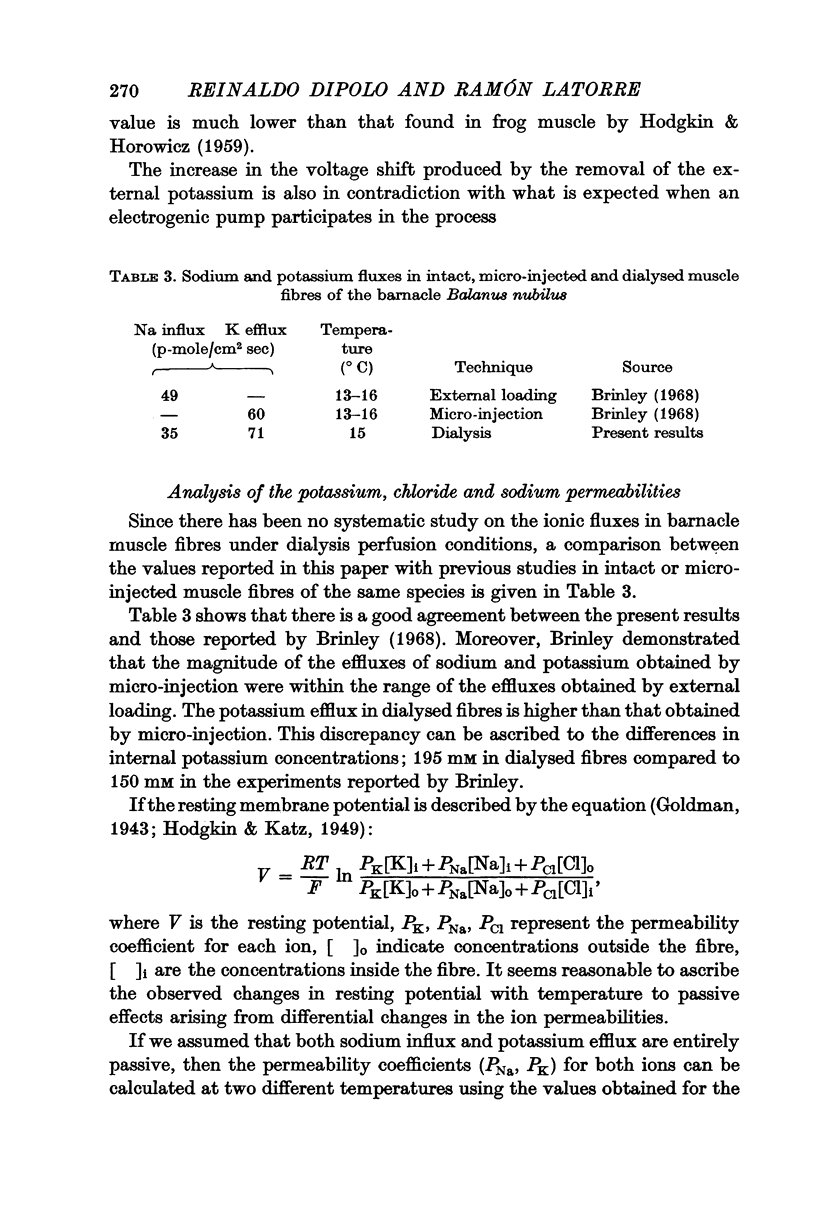

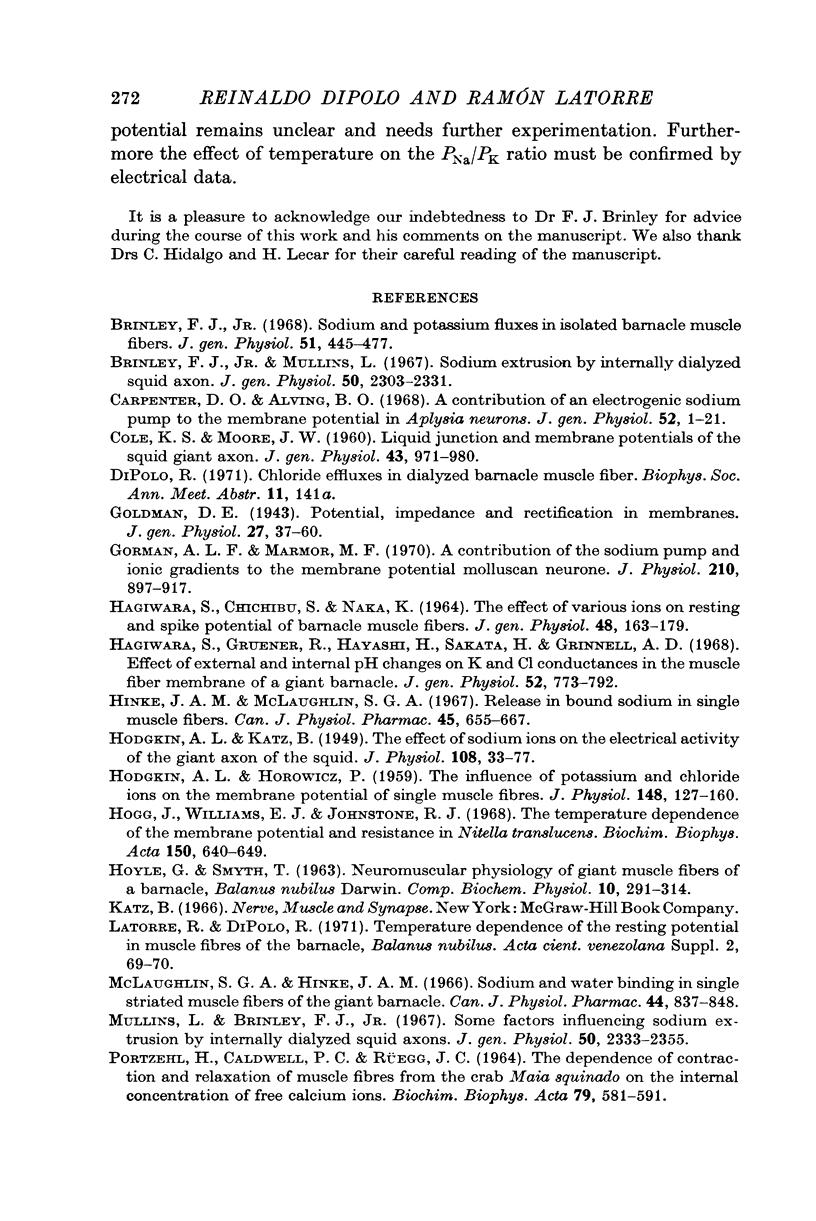
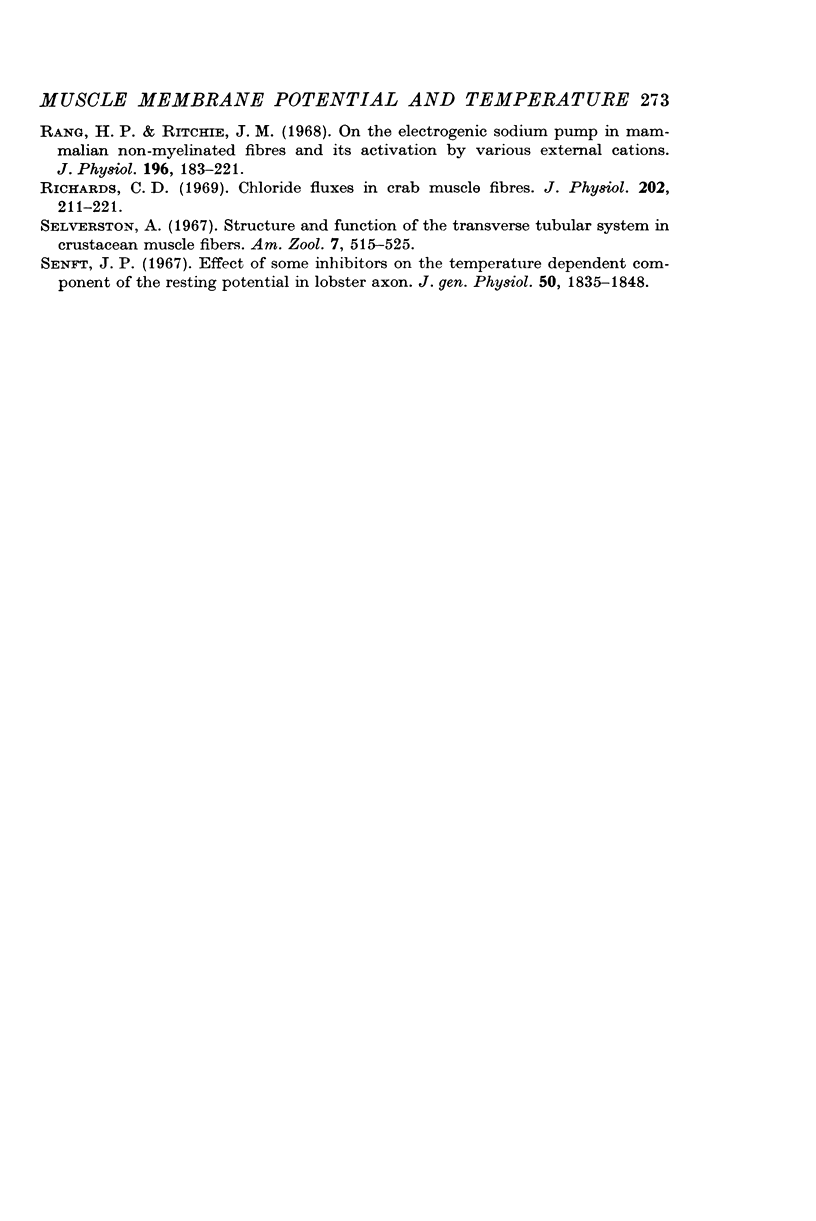
Selected References
These references are in PubMed. This may not be the complete list of references from this article.
- Brinley F. J., Jr, Mullins L. J. Sodium extrusion by internally dialyzed squid axons. J Gen Physiol. 1967 Nov;50(10):2303–2331. doi: 10.1085/jgp.50.10.2303. [DOI] [PMC free article] [PubMed] [Google Scholar]
- Brinley F. J., Jr Sodium and potassium fluxes in isolated barnacle muscle fibers. J Gen Physiol. 1968 Apr;51(4):445–477. doi: 10.1085/jgp.51.4.445. [DOI] [PMC free article] [PubMed] [Google Scholar]
- COLE K. S., MOORE J. W. Liquid junction and membrane potentials of the squid giant axon. J Gen Physiol. 1960 May;43:971–980. doi: 10.1085/jgp.43.5.971. [DOI] [PMC free article] [PubMed] [Google Scholar]
- Carpenter D. O., Alving B. O. A contribution of an electrogenic Na+ pump to membrane potential in Aplysia neurons. J Gen Physiol. 1968 Jul;52(1):1–21. doi: 10.1085/jgp.52.1.1. [DOI] [PMC free article] [PubMed] [Google Scholar]
- Goldman D. E. POTENTIAL, IMPEDANCE, AND RECTIFICATION IN MEMBRANES. J Gen Physiol. 1943 Sep 20;27(1):37–60. doi: 10.1085/jgp.27.1.37. [DOI] [PMC free article] [PubMed] [Google Scholar]
- Gorman A. L., Marmor M. F. Contributions of the sodium pump and ionic gradients to the membrane potential of a molluscan neurone. J Physiol. 1970 Nov;210(4):897–917. doi: 10.1113/jphysiol.1970.sp009248. [DOI] [PMC free article] [PubMed] [Google Scholar]
- HAGIWARA S., CHICHIBU S., NAKA K. I. THE EFFECTS OF VARIOUS IONS ON RESTING AND SPIKE POTENTIALS OF BARNACLE MUSCLE FIBERS. J Gen Physiol. 1964 Sep;48:163–179. doi: 10.1085/jgp.48.1.163. [DOI] [PMC free article] [PubMed] [Google Scholar]
- HODGKIN A. L., HOROWICZ P. The influence of potassium and chloride ions on the membrane potential of single muscle fibres. J Physiol. 1959 Oct;148:127–160. doi: 10.1113/jphysiol.1959.sp006278. [DOI] [PMC free article] [PubMed] [Google Scholar]
- HODGKIN A. L., KATZ B. The effect of sodium ions on the electrical activity of giant axon of the squid. J Physiol. 1949 Mar 1;108(1):37–77. doi: 10.1113/jphysiol.1949.sp004310. [DOI] [PMC free article] [PubMed] [Google Scholar]
- HOYLE G., SMYTH T., Jr NEUROMUSCULAR PHYSIOLOGY OF GIANT MUSCLE FIBERS OF A BARNACLE, BALANUS NUBILUS DARWIN. Comp Biochem Physiol. 1963 Dec;10:291–314. doi: 10.1016/0010-406x(63)90229-9. [DOI] [PubMed] [Google Scholar]
- Hagiwara S., Gruener R., Hayashi H., Sakata H., Grinnell A. D. Effect of external and internal pH changes on K and Cl conductances in the muscle fiber membrane of a giant barnacle. J Gen Physiol. 1968 Nov;52(5):773–792. doi: 10.1085/jgp.52.5.773. [DOI] [PMC free article] [PubMed] [Google Scholar]
- Hinke J. A., McLaughlin S. G. Release of bound sodium in single muscle fibers. Can J Physiol Pharmacol. 1967 Jul;45(4):655–667. doi: 10.1139/y67-078. [DOI] [PubMed] [Google Scholar]
- Hogg J., Williams E. J., Johnston R. J. The temperature dependence of the membrane potential and resistance in Nitella translucens. Biochim Biophys Acta. 1968 Jun 11;150(4):640–648. doi: 10.1016/0005-2736(68)90053-9. [DOI] [PubMed] [Google Scholar]
- McLaughlin S. G., Hinke J. A. Sodium and water binding in single striated muscle fibers of the giant barnacle. Can J Physiol Pharmacol. 1966 Sep;44(5):837–848. doi: 10.1139/y66-102. [DOI] [PubMed] [Google Scholar]
- Mullins L. J., Brinley F. J., Jr Some factors influencing sodium extrusion by internally dialyzed squid axons. J Gen Physiol. 1967 Nov;50(10):2333–2355. doi: 10.1085/jgp.50.10.2333. [DOI] [PMC free article] [PubMed] [Google Scholar]
- PORTZEHL H., CALDWELL P. C., RUEEGG J. C. THE DEPENDENCE OF CONTRACTION AND RELAXATION OF MUSCLE FIBRES FROM THE CRAB MAIA SQUINADO ON THE INTERNAL CONCENTRATION OF FREE CALCIUM IONS. Biochim Biophys Acta. 1964 May 25;79:581–591. doi: 10.1016/0926-6577(64)90224-4. [DOI] [PubMed] [Google Scholar]
- Rang H. P., Ritchie J. M. On the electrogenic sodium pump in mammalian non-myelinated nerve fibres and its activation by various external cations. J Physiol. 1968 May;196(1):183–221. doi: 10.1113/jphysiol.1968.sp008502. [DOI] [PMC free article] [PubMed] [Google Scholar]
- Richards C. D. Chloride fluxes in crab muscle fibres. J Physiol. 1969 May;202(1):211–221. doi: 10.1113/jphysiol.1969.sp008805. [DOI] [PMC free article] [PubMed] [Google Scholar]
- Senft J. P. Effects of some inhibitors on the temperature-dependent component of resting potential in lobster axon. J Gen Physiol. 1967 Aug;50(7):1835–1848. doi: 10.1085/jgp.50.7.1835. [DOI] [PMC free article] [PubMed] [Google Scholar]


